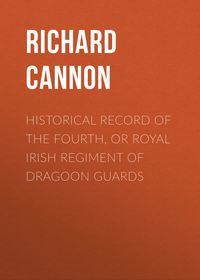 полная версия
полная версияHistorical Record of the First Regiment of Foot
While the Scots regiments in the service of France were gaining laurels in Italy and Flanders, England continued the theatre of civil war, and many desperate engagements were fought with varied success. At length the King's army, after suffering a series of reverses, was found unable to withstand the forces of the Parliament; and a number of officers and soldiers, who had fought in the royal cause, fled to France, and were taken into the service of Louis XIV. Five English battalions were formed, and added to the French army in Flanders; and, during the campaign of 1646, the British troops were employed in the siege and capture of Courtray, a considerable town on the river Lys; and they afterwards took a distinguished part in the siege of the city of Dunkirk, which surrendered to the French army on the 10th of October, 1646.
1647The British troops continued to take part in the war in Flanders: and in 1648 a troop of Scots cuirassiers, and the regiment of Scots Guards, had an opportunity of distinguishing themselves at the battle of Lens,40 in Artois, under that distinguished commander the Prince of Condé. This battle was fought on the 10th of August, 1648. The Spanish army, commanded by Archduke Leopold, suffered a complete overthrow, and lost thirty-eight pieces of cannon, and upwards of one hundred standards and colours.
Soon after this victory an insurrection broke out in Paris; the court removed to Rouel, and afterwards to St. Germain, and part of the army was recalled from Flanders to besiege the capital, and to reduce the Parliament of Paris to obedience.
16481649In this year (1648) a treaty was concluded at Munster, which restored peace to a great part of Europe, but the war was continued between France and Spain, and the British troops were continued in the service of France. Meanwhile King Charles I. of England, having fallen into the power of Cromwell, was beheaded at Whitehall Palace on the 30th of January, 1649.
While these events were taking place in other parts of Europe, Paris was besieged by the French army, of which Douglas' Regiment continued to form a part; but an amicable arrangement between the Court and Parliament took place in the spring of 1649. This was, however, followed by insurrections in several of the provinces, and the Spanish commanders, availing themselves of the distracted state of France, recaptured several places in the Netherlands.
While France was disturbed with internal commotions, three hundred veteran Scots, who had been left in garrison at Ypres in West Flanders, were engaged in the defence of that place against the Spaniards, and, after a gallant resistance, were eventually forced to surrender: but obtained honourable conditions, and marched out on the 6th of May, 1649, with drums beating and colours flying.
1650The commotions in France occasioned a decrease in the revenues of Louis XIV., and Douglas' veterans, with the other Scots regiments in the French service, could not procure their pay. Meanwhile, King Charles II., who had been an exile on the continent for some time, was entering into a treaty, called the Covenant, with the Scots, through whose means his Majesty expected to recover the sovereignty of Great Britain; at the same time, application was made to the French court for permission for Douglas' and the other regiments to return to Scotland with the King; but these gallant veterans were so beloved and esteemed in France for their good conduct on all occasions, that Louis XIV. declined to accede to this request, and promised to give them their pay with greater regularity in future.
1651Had these distinguished regiments accompanied their sovereign to Scotland, great advantage would, doubtless, have accrued to the royal cause. But, instead of accompanying their King, they were employed in the defence of several strong towns on the frontiers of Picardy and Flanders. The internal disorders in France continued, a want of money prevailed in the army, and many of the French soldiers deserted. At the same time the Spaniards, being in communication with the disaffected in France, recovered several more of the towns which had been wrested from them in the preceding campaigns, and besieged Dunkirk.
While these events were occurring on the continent, Charles II. was crowned King in Scotland; but his affairs not prospering in the north, he penetrated into England, and the Scots troops sustained a decisive overthrow at Worcester on the 3rd of September, 1651. The King fled from the field, and, after remaining in concealment with several loyal families for a short time, he escaped in disguise to France.
Meanwhile, the troubles in France were increasing. The Duke of Orleans and the Prince of Condé were opposed to the court; the latter was at the head of an army; and Douglas' Regiment was employed in operations against the insurgents.
1652After several marches and manœuvres, the opposing armies came in contact in the summer of 1652, in the vicinity of Paris; the royal army was commanded by Marshal Turenne; and the rebel army by the Prince of Condé, who erected barricades in the Fauxbourg of St. Antoine, where he was attacked on the 2nd of July, 1652.41 The fighting had been continued for some time with great resolution on both sides, when Douglas' and three other regiments attacked a barricade across one of the streets near the river, which they carried sword in hand, and, having dislodged the enemy from the houses, established themselves on this spot. Immediately afterwards a troop of royal horse, attempting to pass the barricade, was repulsed by the insurgent horsemen, who were driven back in their turn by the fire of Douglas' and another regiment from the houses. Scarcely had the horse quitted the street, when two bodies of insurgent foot came rushing forward with great fury to retake the barricade, but Douglas' and another regiment opened so destructive a fire from the houses, and the regiments which guarded the barricade made so resolute a defence, that the rebels were repulsed with great loss. A general attack was afterwards made on the other posts occupied by the rebels in the suburbs of Paris, and the rebellion would probably have been crushed at once, but the Parisians opened their gates and admitted the insurgents into the city, and thus protected them from the fury of the royal army. The city of Paris having thus manifested a determination to take part with the insurgents, Douglas' Regiment, with the remainder of the royal army, retreated on the same day to St. Denis, where his Majesty and the court had retired.
While the Prince of Condé held possession of Paris, and the royal army lay at St. Denis, a large Spanish army prepared to penetrate from the Netherlands into France, to act in concert with the French insurgents; when the court of Louis XIV. removed to Pontoise, and the army marched to Compeigne, and encamped under the walls of the town. The Spanish army entered France, but after a short stay it retired to the Netherlands, when the army of Louis XIV. advanced towards Paris, and encamped near Gonesse. This movement was followed by the return of the Spanish forces under the Duke of Lorraine, when the army under Marshal Turenne attempted to intercept the enemy, and a sharp skirmish occurred at Villeneuve St. Georges, nine miles from Paris, and the designs of the Duke of Lorraine were frustrated. But the Prince of Condé marched out of Paris, and succeeded in forming a junction with the Spaniards at Ablon; and the united armies were double the number of the forces under Marshal Turenne, who constructed two temporary bridges over the Seine, threw up entrenchments, and maintained his post for several weeks. While the two armies confronted each other, frequent skirmishes occurred in the fields and vineyards, in which Douglas' Scots took a conspicuous part. On one of these occasions a captain of the regiment was taken prisoner, who escaped from the enemy a few days afterwards, and brought information that the Prince of Condé had left the Spanish army in consequence of indisposition. The enemy not being so watchful as before, and the King's army being in want of provisions, it retired with great secrecy during the night of the 4th of October, and continued its march to Courteuil, when the enemy quitted the vicinity of Paris, and marched into winter quarters in Champagne and other parts of France.
When the absence of the united rebel and Spanish army from Paris was ascertained, the royal family of France proceeded with a strong guard to the capital, and obtained possession of the city; and Douglas' Regiment, with the remainder of the King's army, marched for Champagne, to attack the enemy in his quarters.
During the winter Douglas' Regiment was engaged in the siege of Bar le Duc; the lower town was taken by storm, and, about the middle of December, when two practicable breaches were made, the upper town and castle surrendered; when an Irish regiment in the Spanish service was made prisoners. The Irish finding that the Duke of York was with the French army, in command of the Scots gendarmes and a regiment of foot called the Regiment of York, they obtained permission to enter the French service, and were incorporated into the Duke's regiment.
From Bar le Duc, Douglas' Regiment marched a distance of nine miles, to Ligny, a town situate on the river Ornain, and was engaged in the siege of the castle. A mine being ready, on the 21st of December, "Marshal Turenne commanded the regiments of York and Douglas to prepare for the attack at the springing of the mine, and ordered his own regiment to be in readiness to second them. All things being prepared in this manner, fire was given to the mine, and in the midst of the smoke, before it could be discerned what effect the mine had produced, the Count d'Estrées, who commanded the attack, ordered it to be instantly made. Accordingly, they fell on, passing over the ditch, which was very broad, upon the ice. But when they came to the ditch, they perceived that the mine had failed their expectation, and there was no possibility of mounting the breach. Upon this there was a necessity of making a retreat; the ice broke under the men, and most of them fell into the ditch, which gave leisure to the enemy to do execution on them. Thus, for want of a little patience to see what effect the mine had wrought; the regiment of York lost four captains, some lieutenants and ensigns, and about a hundred men, slain outright, and the regiment of Douglas two captains and near fifty private soldiers; besides many officers and soldiers hurt."42 Immediately after this failure another mine was commenced, and the garrison surrendered on the 22nd of December.
1653A garrison having been placed in Ligny, the army proceeded to Château Portien, a small town of the Ardennes, situate on the right bank of the river Aisne; and while on this march the weather was so severe, that several of the soldiers were frozen to death on the road. The siege of this place was commenced in the beginning of January, 1653, and the town was delivered up in less than ten days.
Having completed this conquest, the troops proceeded through a difficult tract of country, and besieged Vervins. The weather continued inclement, the men were suffering from the want of food, and great difficulties had to be overcome; yet the attacks were made with such spirit and determination, that possession was gained of this town on the 28th of January.
The troops were now exhausted, and Douglas' Regiment was sent into quarters of refreshment. It again took the field in June following; but the enemy had so great a superiority of numbers, that the greater part of the year was passed in defensive operations.
16541655The regiment appears to have passed the year 1654 in garrison. In 1655 it was employed in the Netherlands; its Colonel, Lieutenant-General Lord James Douglas, commanded a flying camp between Douay and Arras; several skirmishes occurred, and on one occasion Lord James Douglas was killed; he was succeeded in the Colonelcy by his brother, Lord George Douglas, afterwards Earl of Dumbarton. This change in its Colonel did not alter the title of the corps, as it continued to be distinguished by the title of Douglas' Regiment.
This year (1655) the King of France concluded a treaty with Cromwell, who was at the head of the British nation with the title of Lord Protector; and it was stipulated that a body of Cromwell's forces should proceed to Flanders to co-operate with the French against the Spaniards.
165616571658This treaty occasioned King Charles II. to unite his interests with those of Spain; the Duke of York quitted France, and obtained a command in the Spanish army; and a great part of the Royal British troops, which had escaped from England and entered the French army, transferred their services from the crown of France to that of Spain. The cavalier gentlemen, who thus transferred their services to the crown of Spain, were formed into a troop of Horse Guards, of which Charles Berkeley (afterwards Earl of Falmouth) was appointed Captain and Colonel; and the remainder were formed into six regiments of foot – one English, one Scots, and four Irish.43 The determination thus manifested, by the British troops in the service of France to preserve their loyalty to King Charles II., appears to have occasioned measures to be adopted by the French commanders to prevent Douglas', and the other old Scots regiments, from following this example; and these corps appear to have been placed in remote garrisons, as they are not mentioned in the histories of the military transactions in the Netherlands in 1657 and 1658, in which years the French army and Cromwell's forces captured St. Venant and Mardyk, defeated the Spanish army, and afterwards took Dunkirk, Ypres, Bruges, Dixmude, Furnes, Gravelines, Oudenarde, and Menin; and Dunkirk was occupied by the English.
1659In September, 1658, Cromwell died; and in 1659 the Prince of Condé disbanded his forces, and having tendered his submission to the crown of France, he was received into the favour of Louis XIV. At the same time a treaty of peace, called the Peace of the Pyrenees, was concluded between France and Spain, and Dunkirk was ceded to England.
1660After this treaty was concluded the strength of the French army was decreased, and Douglas' Regiment was reduced to eight companies. These events were followed by the restoration of King Charles II. to the throne of Great Britain; when the British troops which had been in the service of Spain were placed in garrison at Dunkirk; and Douglas' Regiment, in the French service, was in garrison at Avennes.
1661Soon after the restoration, King Charles II. disbanded the army of the Commonwealth, which he found in England at his return. It was, however, deemed necessary to have a regular force established, for in January, 1661, a number of religious fanatics, called millenarians, or fifth monarchy-men, took arms against the government, and, although this insurrection was suppressed in a few days, yet it was deemed necessary to send for the Duke of York's troop of Guards from Dunkirk, and afterwards for Douglas' veteran Scots regiment from Flanders.
The regiment having arrived in England in the spring of 1661, it obtained rank in the British army from that date. It appears, however, to have had rank in the Swedish army from about the year 1625, and in the French army from 1633. No instance has been met with of its having been distinguished by any other title than the name of its Colonel, except during part of the time it was in the Swedish service, when it was designated, together with three other Scots regiments of which it is now the representative, the Green Brigade.
Soon after its arrival in England the establishment of the regiment was augmented, and its presence at this particular period was of great service to King Charles II.44 But his Majesty having (after disbanding the whole of the army of the Commonwealth) established three troops of Life Guards, a regiment of Horse Guards, and two regiments of Foot Guards, in England; and a troop of Life Guards, and a regiment of Foot Guards in Scotland; it was not deemed necessary to detain Douglas' veteran corps in England, and it was, accordingly, sent back to France in 1662.
1662At the same time, General Andrew Rutherford, who commanded the battalion of Scots Guards in the French service, having been appointed Governor of Dunkirk by King Charles II., his battalion was incorporated in Douglas' Regiment. There was also another battalion of Scots Foot in the service of France, commanded by Lord James Douglas, and this battalion was likewise incorporated into Douglas' veteran regiment, which now consisted of twenty-three companies of one hundred men each, and its established numbers, including officers and non-commissioned officers, were upwards of 2500.
1663The King of France having, after the treaty of the Pyrenees, placed his army upon a peace establishment, the strength of Douglas' Regiment was reduced to eight companies of one hundred men each.
16651666Three years after its return to France, a war broke out between England and Holland; and in the succeeding year Louis XIV. took part with the Dutch against England, when Douglas' regiment was again ordered to quit the French service, and to return to England: it accordingly landed at Rye, in Sussex, on the 12th of June, 1666, and mustered eight hundred men.45
The Roman Catholics in several counties in Ireland were, at this period, in a state of insurrection; and in a short time after the arrival of the regiment from France, it was ordered to proceed to Ireland, where it appears to have remained upwards of twelve months.
16681670After the conclusion of the peace of Breda in 1668, the insurrections in Ireland having been suppressed, the regiment was again sent to France; and in an order issued by Louis XIV. in 1670, respecting the rank of regiments, it appears one of the first.46
1672A war commenced in 1672 between the French monarch and the States General of Holland; King Charles II. of England also declared war against the Dutch; and a British force, commanded by the Duke of Monmouth, was sent to France to co-operate with the army of Louis XIV. in an attack upon Holland. Douglas' Regiment had, in the meantime, been augmented to sixteen companies, and when the army took the field, it formed two battalions; and was in the division of the army commanded by Marshal Turenne. Several fortified towns were captured by the main army; and in June, Douglas' Regiment, being encamped in the vicinity of Nimeguen, was detached with several other corps under the Comte de Chamilly to besiege Grave. The attack on the town commenced towards the end of June, and in the early part of July the governor surrendered. A number of the subjects of the British crown, who had entered the service of Holland, being found in garrison, they were permitted to engage in the service of Louis XIV., and were received as recruits in Douglas' Regiment.47 In August the regiment was withdrawn from the vicinity of Grave, and ordered to join the forces under Marshal Turenne.
1673In 1673 eight thousand British troops served with the French army, and were engaged in the siege of Maestricht, in which service they evinced signal gallantly; and in repulsing a sally of part of the garrison, the Duke of Monmouth, Captain Churchill (afterwards the great Duke of Marlborough), and twelve private men of the English Life Guards (a squadron of which corps was serving with the French army), highly distinguished themselves.48 The town surrendered on the 2nd of July.
1674Before the following year King Charles II. concluded a treaty of peace with the Dutch Republic; but his Majesty did not withdraw the whole of his troops from France; and during the campaign of 1674 Douglas' Regiment, with the Scots regiment of Hamilton, and the English regiments of Monmouth and Churchill, served with the French army on the Rhine, commanded by Marshal Turenne. In the early part of June, Douglas' Regiment was encamped near Philipsburg,49 a town in the west of Germany about half a mile from the Rhine, and was formed in brigade with the French regiments of Plessis and La Ferté, with a battalion of detachments, commanded by Brigadier-General the Marquis of Douglas.50
The opposing armies having taken the field, Douglas' Regiment was suddenly withdrawn from the vicinity of Philipsburg, and, after crossing the Rhine, advanced towards the ancient city of Heidelberg, to prevent the junction of the forces under the Duke of Lorraine and the army commanded by the Duke of Bournonville. This movement brought on several skirmishes, in which the regiment took part; it was also engaged in a sharp action on the 16th of June, when the Imperialists were defeated; and in the accounts of this action published at the time, the conduct of the regiment is spoken of in terms of commendation.
After chasing the enemy out of the Palatinate, the regiment retired with the army across the Rhine, to join the reinforcements from Alsace and other places; and after the arrival of these troops, the army re-passed the Rhine, and Douglas' and two other regiments were detached to the vicinity of Landau, and ordered to encamp within a league of the town. The regiment was subsequently detached towards Manheim, and, after taking part in several operations, in the beginning of October it was encamped at Lavantzenaw, in Alsace.
Information having been received that the Germans had passed the Rhine and advanced to Molsheim, the French and British troops quitted their camp about an hour after midnight on the 3rd of October, and after a march of several hours, arrived at the enemy's camp, and attacked them with great spirit. The conflict took place amongst woods and broken grounds, and the British troops displayed signal gallantry, fighting with a spirit and resolution which the enemy could not withstand. Many officers and men fell, yet the conflict was continued, and Lord Duras (afterwards Earl of Feversham) had three horses killed under him. Eventually the enemy were driven from the field, with the loss of ten pieces of cannon, thirty standards and colours, and several prisoners.51
The Germans were subsequently reinforced by a number of fresh troops, when Marshal Turenne retired with the French and British forces, and took up a position near Saverne in Alsace, by which he prevented the Imperialists deriving much advantage from their superiority of numbers.
1675During the depth of the winter, when the Germans had retreated, Douglas' Regiment52 was placed, with several other corps, under the orders of the Marquis of Vaubrun, and engaged in the siege of Dachstein, a town in the department of the Lower Rhine. The trenches were opened during the night of the 25th of January, 1675; and during the night of the 28th, Douglas' veterans were engaged in storming the works, and lost several officers and men. Amongst the killed was the Major of the regiment, who is stated by the French historians to have been an officer of great merit. On the following day the governor surrendered the town, when the regiment was sent into quarters.
It again took the field in the month of May, and was encamped for a short time near Strasburg; at the same time the Germans, under the Count de Montecuculi, menaced the city of Philipsburg with a siege; but the French and British forces passed the Rhine on the 7th of June, when the Germans changed their position, and the two armies confronted each other, and manœuvred for several days in the territory bordering on the Rhine. Douglas' Regiment, having been on a detached service for some time, was suddenly ordered to join the main army, from whence it was afterwards sent to Treves to reinforce the garrison. Several sharp skirmishes occurred; and on the 27th of July, as Marshal Turenne was reconnoitring the enemy, he was killed by a cannon-ball. After the death of this celebrated veteran, the army was commanded ad interim by the Count de Lorge, who retreated across the Rhine. The Germans attacked their adversaries while making this retrograde movement, when the gallant conduct of two battalions of veteran Scots saved the main army from a severe loss. Treves was afterwards besieged by the Germans, and Douglas' Regiment highly distinguished itself in the defence of this ancient city, under the command of Marshal de Crequi. The French troops mutinied, and endeavoured to compel the governor to surrender, but Douglas' Scots stood by the Marshal in the desperate defence of the town, and were thanked for their conduct by Louis XIV. Treves was surrendered on the 5th of September, and the regiment was bound by the articles not to serve for three months, either in the field or in the defence of any town.





